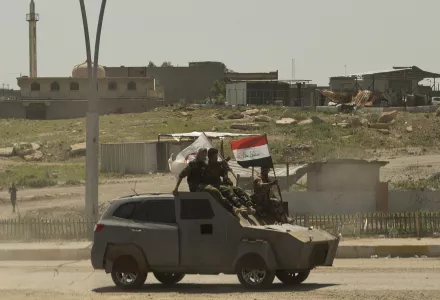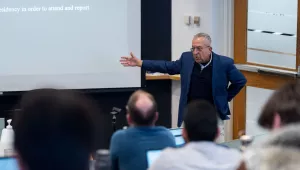
Sleeper Cells are on the Minds of Many in a Liberated Mosul
The six-month Mosul operation will soon come to an end. Civilians and soldiers alike are eager to turn over a new page after years of ISIS control over the city. Unfortunately, it is unlikely that this will come to pass. The security problems that will follow are already visible in other Iraqi cities of Iraq, such as Falluja and Ramadi, which had been liberated from ISIS prior to the Mosul operation.
Last month, a high-level government meeting on the "post-ISIS situation" took place. But beneath the surface, even the idea of before and after, of a "post-ISIS moment" seems uncertain. This is because ISIS insurgencies and sleeper cells at various stages of activation exist across many areas that are now considered to have been liberated. If, in liberated East Mosul they are still mostly dormant, in Fallujah and Ramadi they are already active. Only last week there were clashes between ten ISIS militants dressed in police uniforms and Iraqi security forces in Tikrit, Iraqi security forces’ military bases were attacked in Hamrin and Sadyah, and ISIS insurgents were trying to take control of Amriat Faluja (a town near Falluja). And although efforts to ferret them out are ongoing, the Iraqi security forces’ record of success has been mixed at best.
Who populates those sleeper cells? Post-ISIS insurgencies in rural areas mostly consist of people who are known to the police forces because they did not hide their identities while in ISIS and now have fewer options other than taking cover in swamps and forests; sleeper cells in towns are different. Sleeper cells' primary human resources are people who are not known to the government security apparatus. These people were hiding their identities even when ISIS was in control, and although they were active in ISIS, they never publicly identified themselves as members. As a result, they are not in the intelligence data base that everyone coming from ISIS-held territories is checked against. So while those cells have women, they are strictly local—no foreigners who are highly visible and could endanger the rest of the group. And if in Mosul there are no new members who would join sleeper cells, the situation differs from that in previously liberated areas. In those places, people are disappointed with how the government is handling post-ISIS territories, and they are now joining sleeper cells. And if defeating an insurgency is a question of force and strategy, then neutralizing sleeper cells requires reliance on intelligence and civilian cooperation.
Fear of sleeper cells is real and justified. It is also dizzyingly complex for already-exhausted Iraqi security forces. Sleeper cells are different in each location and often differ according to when a particular town was liberated. Paradoxically, the more time that has elapsed since liberation, the more active the ISIS sleeper cells are.
Falluja and Ramadi were both liberated in 2016, and the cells there are now active: deploying car bombs; placing roadside and sticky bombs that target the Iraqi armed forces; and threatening and kidnapping local politicians (both for ransom and to intimidate them from working with the government). While in East Mosul, the cells are mostly quiescent, waiting because too much attention is focused on the area. To date, there have been only minor suspicious incidents; for example a man on a motorcycle tried to attack a military checkpoint but failed and was detained.
The absence of major attacks is little cause for comfort for the security forces in Mosul. Instead, precedent suggests that sleeper cells exist, and they are likely watching, using different forms of intelligence collection: identifying people who work with the government; providing coordinates for mortar fire; and even installing amplifiers that help small drones (such as the DJI Phantom 4–the ISIS drone of choice) fly further without losing its signal. For example, two weeks before military bases in Sadyah were attacked, three ISIS surveillance drones, trying to take images of security forces, were shot down nearby.
There is a deeper fear, too. Cells like these are almost infinitely sustainable—they have enough remaining weapons hidden away in holes or buried in the backyards of their houses. With a shift from open combat to sustained insurgency, the weapons that they now employ are home-made—explosives fashioned on kitchen tables so that cell members cannot be discovered by tracing supply routes.
Part of ISIS' past success has been due to their adaptability. The organization is adept at devising security measures for a particular area. Their hiding tactics follow suit and have been successful to varying degrees. For example, in Khanakin, an area under Kurdish control, security forces are less concerned because many ISIS families are closely watched. This forces ISIS militants to hide with people who are not relatives, but it also means that they form relationships with people who are less likely to be known to the intelligence apparatus.
The situation in East Mosul is different, largely because ISIS militants are being protected by their families. They do not need to leave their homes for support, and they still retain an extensive network of underground tunnels in which to hide. In one family, two daughters were married to high ranking ISIS members—one of which had been a member of Hisbah (ISIS religious police). Security forces raided the house and found one woman who said that she was divorced and that her sister had moved to West Mosul with ISIS, so she now lives alone. But later she was spotted with her family members in the local market.
The situation is even more confusing for the security forces because of the number of Internally Displaced Person (IDPs) who relocated—not just between ISIS-controlled towns—but also between different neighborhoods within Mosul. Many people from Falluja moved to Mosul two months after ISIS had captured Mosul and occupied houses that had been abandoned by people who had been targeted by ISIS, such as Christians.
Moving into a ISIS-held city, they were assigned houses, paying rent of $20 per month. With ISIS gone, these people who are somehow connected to ISIS remain. But they are not well known to the neighborhood, and the security services possess little information about them.
Nor do the security services provide any guarantee that sleeper cells will be rooted out. Despite efforts to end it, widespread corruption still exists within the ranks of the Iraqi security apparatus. If they fear being discovered or want to reinforce another area, ISIS sleeper cells members could move to another town with relative ease.
There are signs that the Iraqi government is trying to approach things differently, fighting insurgents in ways other than with the straightforward use of force. In northern Salahadin, villagers who are returning to their homes have to sign a paper guaranteeing that they are willing to fight ISIS and provide weapons for the effort. Not only does the government gain fighters, but such cooperation immediately makes these combatants enemies of ISIS. Now, even if they had given up fighting, they have been forced to choose a side and are now armed.
Methods of fighting sleeper cells differ. Identifying ISIS militants is a job for intelligence forces, and they mainly rely on information from local civilians. According to Faisal Jeber, who is the leader of one of the Tribal Mobilization (TM) groups, Mosul's Gallants Force, which is in charge of security in one of the East Mosul neighborhoods, "When someone reports an ISIS fighter to us, we first check the reporter to learn about his motives. Why did he decide to inform on us, and why now?" After an initial interrogation, the informant is sent home, and "we pretend that we did not take his information seriously." After that, an investigation starts by collecting more information from neighbors. Usually two to three positive reports are needed for an arrest.
About half of all initial tips are result in an arrest. "And it is not only because people are making false accusations," says Jeber, "but also because there are different shades of gray of ISIS members. It is not clear what being with ISIS means—a person could be an Emir who was ordering beheadings or someone who was in charge of traffic in the city."
Once a person is detained, he is sent to a federal jail where, in order to be convicted, two witnesses are needed. This can be an additional challenge because people in those areas are still fearful. Even after a town has been liberated, some civilians do not want to shave their beards in fear that ISIS will be back and will punish them for doing so.
The intelligence services' approach is complicated and requires surgical precision, because every misstep can feed recruitment for ISIS. Before ISIS took control of Iraqi territory, the Iraqi police system had filled its ranks with unprofessional and corrupt officials. When ISIS wanted to target someone for recruitment, they would report him to the security apparatus as already being a member of ISIS. He would be arrested. Many were beaten and tortured, and money was extorted from their families in order to get them released from prison. It comes as no surprise that such experiences with Iraqi government institutions fed ISIS recruitment. To avoid these previous mistakes, a more careful system of arrests is now in place, but in East Mosul, the arrests still occur daily.
In hiding, ISIS members still threaten security forces. For example, a leader of a TM force is getting regular threats by telephone and on Facebook. Since the TM force is using a house once inhabited by an ISIS Emir—who is now in West Mosul—and which was also used as a car bomb factory, it is the target of mortars coming from West Mosul. The closest landed fifty meters away, but did not explode.
Despite the military threat that they pose, sleeper cells are also a political problem for the Iraqi government, in part because of the response to those cells. Despite reports to the contrary, Shia Popular Mobilization Units (PMU)s are widely deployed. In charge of ensuring security, they are deeply unpopular in Sunni-dominated areas. And although Sunni militias are also present in the area, there is a rumor among locals that those Sunnis had converted to Shia Islam. The names of the Sunni militias as well as their flag colors and the green ribbons that they wear on their uniforms inspire this rumor because these things all have Shia connotations. ISIS sleeper cells have moved swiftly to exploit this situation. In Falluja, ISIS attacks on Shia PMUs are decreasingly condemned by a local Sunni residents—meaning that in the conflict between Shia PMUs and ISIS, more people are siding with ISIS.
The confusion is compounded by the military bureaucracy and overlapping authority, a problem that is now even recognized by the government itself. "We do not have a central command to run security operations—each of the groups works based on their own internal order and there is no cooperation. This created a gap," says Ismail al-Halub, deputy governor of Salahadin Province, one of the most ISIS-affected regions of Iraq.
According to Mosul's Gallants Force Leader Jeber, this problem could be only solved in Mosul by organizing a clearer and more streamlined security structure to conduct operations "If we get a permit, we will just check and clean house by house, street by street and neighborhood by neighborhood." Lack of clear authority not only impedes the successful elimination of ISIS sleeper cells but increases anti-Iraqi grievances and thus, potential support for ISIS. Frustrations among locals in Falluja give an indication of the simmering tensions. Angered by the time it takes to pass the main Sqoor checkpoint between Baghdad and Falluja, which is administered by the Iraqi police and intelligence services, they blame the incompetence of the security forces. The line sometime stretches to at least two kilometers in length. Elimination of these checkpoints, which many found to be humiliating, was one of the achievements that ISIS received much credit for. The return of these frustrations among the local population it is a dangerous sign.
If these problems are not solved, places like Mosul could become hotspots for a resurgence of ISIS, and sleeper cells could again become the sign of that resurgence. They maintain the connection between ISIS and its former territories, acting as an advance force. In Kirkuk, in October 2016, a group of ISIS militants entered the town and took control of several neighborhoods, all with the help of sleeper cells. In Tikrit and Samara, car bombs (VIBEDS) manufactured by ISIS were positioned in town with the help of sleeper cells which had knowledge of local security. The longer the Iraqi government goes without taking an active role in solving corruption problems, policing problems, and problems related to governance, the greater the likelihood that people will want to join and try ISIS governance again. There are those in their midst who still want to do both.
Statements and views expressed in this commentary are solely those of the author and do not imply endorsement by Harvard University, the Harvard Kennedy School, or the Belfer Center for Science and International Affairs.
Mironova, Vera. "Fearing ISIS in the Shadows." Belfer Center for Science and International Affairs, Harvard Kennedy School, April 20, 2017





